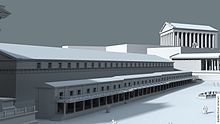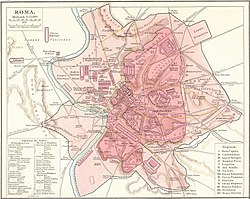 A modern model of Basilica Sempronia | |
| Coordinates | 41°53′31″N 12°29′06″E / 41.891979°N 12.484884°E |
|---|---|
| Type | Basilica |
| History | |
| Builder | Tiberius Sempronius Gracchus |
| Founded | 169 BC |
The Basilica Sempronia was a structure in the Roman Forum during the Republican period.[1] It was one of four basilicas to make up the original Roman Forum alongside the Basilica Porcia, Basilica Aemilia, and Basilica Opimia, and was the third built.[2] Although excavations have revealed remains of the basilica as well as the structures that originally stood in its place, none of them are visible from the Roman Forum.[3][4]
Construction
Excavation of the basilica revealed that it was most likely constructed using tufa blocks, as was common in buildings of the time. Weak areas in the building may have been reinforced with travertine blocks, and the entire facade would most likely have been covered in stucco to hide the masonry as well as decorate it. The roof would have resembled those of temples and would have been made of wooden trusses and beams. The exterior of the roof would have been covered in tiles to protect the roof from the elements, and the interior would have been coffered to lessen the weight and finished in stucco.[3]
History

The Basilica Sempronia was built in 169 BC by Tiberius Sempronius Gracchus, a Roman political figure who was chosen censor at the time of the basilica's creation. It was built over an area that once held the house of Scipio Africanus and a variety of shops, leading the belief that the land once owned by Scipio was inherited by Tiberius in 184 BC upon Scipio's death, as Tiberius was married to his daughter, Cornelia Africana.[4]
In 54 BC, the Basilica Sempronia was demolished by Julius Caesar in order to build his Basilica Julia.[2][3][4]
See also
References
- ^ John Henry Middleton (1892). The Remains of Ancient Rome. A. and C. Black. p. 269.
- ^ a b Stambaugh, John (1988). The Ancient Roman City. Baltimore and London: The Johns Hopkins University Press.
- ^ a b c Gorski, Gilbert (2015). The Roman Forum: A Reconstruction and Architectural Guide. Cambridge, England: Cambridge University Press. pp. 12, 248. ISBN 9780521192446.
- ^ a b c Claridge, Amanda (1998). Rome: an Oxford Archaeological Guide. Oxford Paperbacks. ISBN 978-0-19-954683-1.










